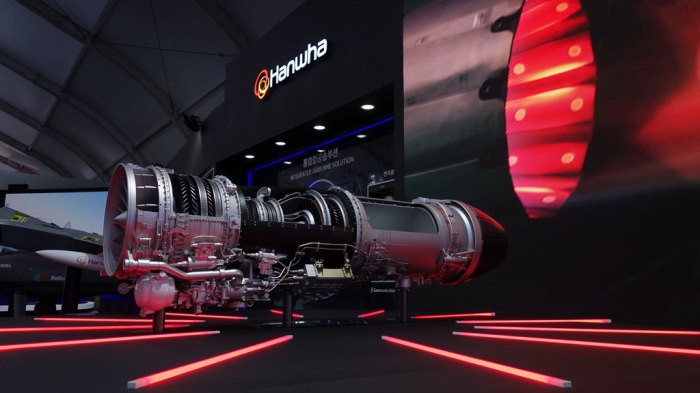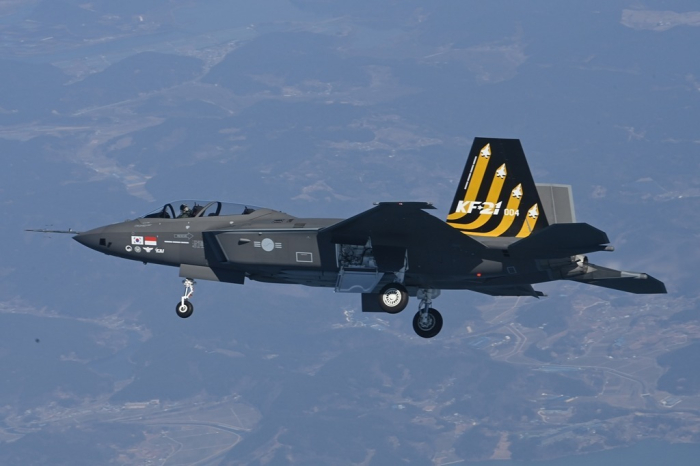S.Korea’s Hanwha, Doosan to develop fighter jet engines
The homegrown fighter jet engine development to allow S.Korea to export warplanes without other countries’ approval
By Jul 02, 2024 (Gmt+09:00)
When in S. Korea, it’s a ritual: Foreigners make stops at CU, GS25, 7-Eleven


Maybe Happy Ending: A robot love story that rewrote Broadway playbook


NPS yet to schedule external manager selection; PE firms’ fundraising woes deepen


Seoul appeal: Korean art captivates Indonesia’s affluent connoisseurs


K-pop stocks surge as China set to loosen cultural ban after 9 years



Hanwha Aerospace Co., South Korea’s top defense manufacturer, and Doosan Enerbility Co., a major local power plant builder, are set to develop engines for fighter jets in the government’s project of more than $2.2 billion to become the world’s seventh country with a homegrown warplane engine.
Hanwha and Doosan each completed the verification of conceptual designs for an advanced fighter jet engine -- an early phase of the design process, in which the broad outlines of function and form of something are articulated – ordered by the Agency for Defense Development last month according to industry sources on Monday.
The two companies plan to work on basic design, which defines the platform, production facility and structural configurations and dimensions in enough detail to allow the detailed design to start, to win a deal for the engine from the Defense Acquisition Program Administration (DAPA).
The state-run arms procurement agency aims to develop a 15000-lb.-thrust-class turbofan engine with investments of at least 3 trillion won ($2.2 billion) in the next 10 years. The KF-21, the country’s first homegrown supersonic fighter jet mass-produced last month, is equipped with an engine with the capacity.
The spending is predicted to rise to more than 5 trillion won as the agency plans to develop materials and parts process technology for the engine, which will be used for a revamped version of the KF-21.
“Hanwha with aircraft engine parts production know-how and Doosan with power plant gas turbine technology jumped into the homegrown fighter jet engine project,” said a DAPA official. “Korea will have a fully homegrown fighter jet if the development of its own engine is succeeded as other components are locally developed.”
AIRCRAFT ENGINE MAKERS’ CLUB
Only six countries – the US, the UK, France, Russia, Ukraine and China – currently have homegrown aircraft engines in the world.
None of them has unveiled the core technology of such engines as it could be used for military aircraft.
In the private sector, US Pratt & Whitney, General Electric Co. (GE) and UK Rolls-Royce Holdings plc dominated the global market with a combined 80% share.
“The Korean defense industry is expected to expand their portfolios into jet fighters from the existing battle tanks, missiles and submarines once the country secures engine technology,” said an industry source.
EXPORT CONTROLS
Hanwha and Doosan aim to avoid defense export controls by other countries through fighter jet engine development.
The Missile Technology Control Regime, an informal political understanding among 35 member states, limits the risks of proliferation of weapons of mass destruction by controlling exports of goods and technologies.
Korea Aerospace Industries Ltd. (KAI), the country’s sole military aircraft manufacturer, has to seek approval from GE, which has a license on the KF-21 engine, for exports of the supersonic warplane.

Hanwha had to get the nod from Germany for exports of its flagship K9 as the self-propelled howitzer is equipped with an engine produced by the country’s MTU Friedrichshafen GmbH. Hanwha failed to export the howitzer to the United Arab Emirates in 2020 as Germany, which designated the engine as a national strategic asset, did not approve it.
The South Korean company developed a 1,000 horsepower tank engine in February and installed it on the K9 for exports without Germany’s approval.
LONG-TERM GOAL
Hanwha set a goal of developing its own fighter jet engine to evolve into a developer with design capabilities as it has been manufacturing core components of aircraft engines with designs of major players such as GE for 45 years.
Hanwha, South Korea’s answer to Elon Musk’s Space X, acquired EDAC Technologies, a US aircraft engine parts maker, for $300 million in 2019, to secure capabilities of rotating parts.
“We can produce all steel components for aircraft engines after obtaining rotating part technology,” said Kim Jong-hoon, Hanwha Aerospace USA's global engineering director. “We also secured the US aircraft engine parts manufacturing network of more than 110 companies.”
Hanwha plans to increase research staff to over 800 by 2028 from the current 250 to speed up the engine development. The company also launched the aircraft engine business division by combining the engine parts, aircraft business and future aviation departments.
Doosan has also been working to develop an engine based on its turbine technology. The company added the production, maintenance, sales and service of aircraft engines and propulsion auxiliary devices into the company’s business purposes in March.
It already secured some core aircraft engine technology, including cooling and coating technology to withstand ultra-high temperatures such as the 1,500 degrees Celsius generated when an engine fires.
“A jet fighter engine is similar to a gas turbine, which burns fuels in condensed air to operate turbines for power generation,” said a power plant industry source.
Write to Hyeon-Woo Oh, Hyung-Kyu Kim and Woo-Sub Kim at ohw@hankyung.com
Jongwoo Cheon edited this article.
-
 Aerospace & DefenseKAI inks $1.4 bn supersonic fighter jet mass production deal
Aerospace & DefenseKAI inks $1.4 bn supersonic fighter jet mass production dealJun 25, 2024 (Gmt+09:00)
2 Min read -
 Aerospace & DefenseHanwha Aerospace closes in on Romania’s howitzer deal
Aerospace & DefenseHanwha Aerospace closes in on Romania’s howitzer dealJun 19, 2024 (Gmt+09:00)
2 Min read -
 Aerospace & DefenseS.Korea’s Doosan Enerbility to develop aircraft engines
Aerospace & DefenseS.Korea’s Doosan Enerbility to develop aircraft enginesMar 27, 2024 (Gmt+09:00)
1 Min read -
 Aerospace & DefenseHanwha Aerospace, home of Korea’s next-generation space industry
Aerospace & DefenseHanwha Aerospace, home of Korea’s next-generation space industryFeb 23, 2024 (Gmt+09:00)
3 Min read -
 Aerospace & DefenseDoosan Enerbility to produce aviation gas turbine with ADD
Aerospace & DefenseDoosan Enerbility to produce aviation gas turbine with ADDAug 21, 2023 (Gmt+09:00)
1 Min read -
 Aerospace & DefenseHanwha Aerospace to develop fighter jet engine materials
Aerospace & DefenseHanwha Aerospace to develop fighter jet engine materialsJul 26, 2023 (Gmt+09:00)
1 Min read


